UAA graduate student Michelle Shero awarded National Science Foundation Fellowship for 3-year study of Weddell seals
by Kathleen McCoy |
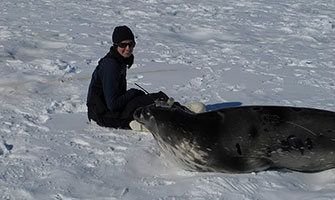
NSF Graduate Fellowship awardee Michelle Shero with a research subject
Biology graduate student Michelle Shero is planning her third trip to Antarctica in October 2012 to check in with her research subjects-a sampling of Weddell seals who live and breed in the McMurdo Sound region of the southernmost continent. She was recently awarded a National Science Foundation Graduate Research Fellowship, an elite program that granted just five awards to Alaska graduate students this year, four from UAF and one from UAA.
Alumni of the NSF Graduate Research Fellowship program have gone on to become Nobel Laureates and members of the National Academy of Sciences as well as hold science and engineering leadership positions in academia, industry, government and the nonprofit sector. But right now, Shero is focused on the next three years where she'll be back and forth between Antarctica and Anchorage. The NSF fellowship will enable her to spend that time studying the dive physiology of the Weddell seals for her graduate research at UAA.
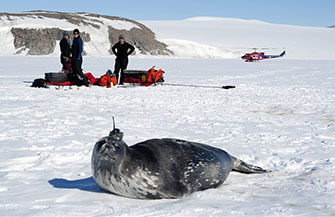
A clear day for Weddell seal field research (Photo by Daniel Costa)
Shero will study the seasonal changes in the seals' physiology and monitor the effects on their diving behavior. During austral spring, which begins in October, the Weddell seals take a break from their active lifestyle. So, Shero aims to find out if the seals are still the same athletes they were after this somewhat sedentary period.
"They have this four-month period where they don't forage a lot and are pretty much hauled out on the ice giving birth to their pups, then it's breeding season and then their molt," Shero says. The seals spend much of the year foraging for food on long dives-up to 80 minutes-and rely on their oxygen stores to sustain them while they're submerged in search of fish, squid and other South Pole seafood delicacies.
"Production of a lot of the oxygen storage proteins is regulated by activity and hypoxia," she says.
After prolonged inactivity, most mammals, to be completely unscientific in terminology, get a little wimpy. Muscles atrophy. The ability to store and distribute oxygen is affected. To determine the seals' aerobic capacity following this period of inactivity, Shero will track tagged seals' dive activity through austral winter via satellite linked dive recorders, which transmit some of the data, allowing her to follow her animals movements and behavior remotely from Alaska, and she'll recapture the animals on site in Antarctica in October to check weight and take blood and tissue samples. She'll be working among a group of researchers and research fellows with complementary projects.
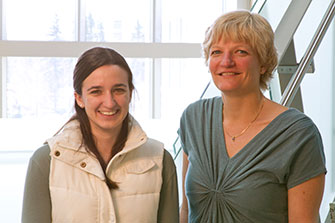
Michelle Shero with her advisor Professor Jennifer Burns
Shero, a Maryland native, gets a mixed response when people hear about her research. "Half the people I tell about working in Antarctica say, 'oh, that's so cool' and half say, 'why would you ever want to go there?'" says Shero.
How did she end up in Antarctica by way of Alaska? It all started three years ago and UAA owes another tip of the hat to the National Science Foundation, which funds Research Experience for Undergraduates (REU) programs across the country. Shero's mentor, UAA biology professor Jennifer Burns, says, "We bring in 10 REU students every summer. It's a really highly competitive program that students from all over the country apply to. Michelle applied in 2009 and I selected her from the whole pile of students that applied."
A student at St. Mary's College of Maryland at the time, Shero came up to Anchorage to work alongside Prof. Burns in the lab analyzing northern fur seal samples. It was easy to talk her into coming up the following summer as well and her second REU project, analyzing Weddell seal samples to determine post-molt physiology, became Shero's senior thesis at St. Mary's and piqued her interest in continued study of the animals.
While they were busy with samples in the lab, Prof. Burns regaled Shero with stories of Antarctica and convinced her to come back as a graduate student to assist her with a collaborative research study on overwinter behavior of Weddell seals. It was a chance to meet some of those research subjects face-to-face. So, she made her first trip down to McMurdo Station, the U.S. Antarctic research facility on Ross Island, in January 2011 alongside Prof. Burns and her research colleagues from University of California-Santa Cruz and Old Dominion University.
Also with them was science teacher Alex Eilers from Tennessee as part of the PolarTREC program. Ms. Eilers photos and travel journal noting her experiences in Antarctica with the Weddell seal researchers is archived on the PolarTREC website <http://www.polartrec.com/member/alex-eilers>.
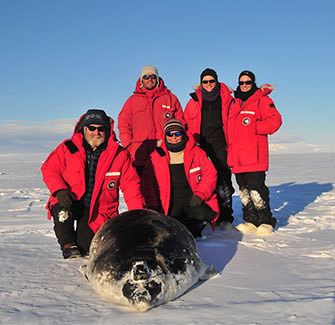
Collaborating researchers with Shero and Burns at right (Photo by Daniel Costa)
So, what's it like to work as a researcher in Antarctica? Summer in McMurdo (September-February) means a peak population of about 2,000 people bustling between dorms, labs and field research sites. It also means 24 hours of daylight, great for reconnaissance or "rekkie" flights in a Twin Otter to pinpoint seal locations and for expeditions out onto the ice by helicopter or snowmachine to tag the animals with the satellite-linked dive recorders, a major part of Shero's first trip, or to gather blood and tissue samples, which will be the purpose of forthcoming trips.
Every newbie at McMurdo is required to attend a survival training orientation. Shero explains, "It's called Happy Camper. You stay out overnight and they tell you how to use the little stoves and set up a tent and use ice blocks to set up a wall so your tents don't get blown over. They teach you how to dig a snow trench and you can sleep in that if you so choose."
Shero was pleased to get a balmy summer night (for Antarctica) when it was her turn to sleep out under the never-setting sun. "It was plus-30 the day I did my Happy Camper, so I slept in the trench," she says. Safety is important at the Antarctic research facility, so in addition to the Happy Camper night out in the elements, McMurdo newbies also get snowmachine training and lab training.
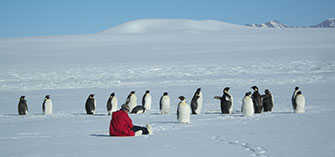
Shero blending in with some visitors
Not everyone understands the draw of working in a polar climate. Although give Prof. Burns a summer in the lab and she might convince you. Some of the attractions are truly unique. "The penguins come and visit sometimes," Shero says. "You can't have that experience anywhere else." And there also aren't too many of us who get to walk up to a marine mammal to collect data, but that's all in a day's work for both Shero and Prof. Burns.
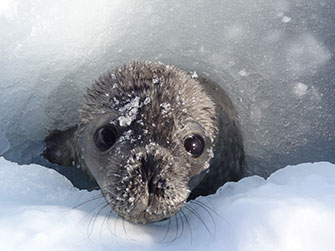
Weddell seal pup
Because there are no terrestrial predators in Antarctica, the Weddell seals are easy to approach, Prof. Burns explains. You can walk up and take a look at their flipper tags without much hassle. Most of the animals they work with have been flipper tagged and a lot of data exists about them already. That accessibility and ready data facilitates Prof. Burns' and Shero's specialized research.
"From the perspective of a marine mammal research biologist, they're a great species to work with," says Prof. Burns. "A lot of climate change issues are going on in the south and in the north, but a lot of the seal species we have in the north are spooked by humans and much harder to get to. We don't have that surrounding infrastructure of support or as much information, so Wedds make a good proxy for species in polar climates on whom we can't get data easily."
Prof. Burns' and Shero's seal research on the opposite side of the globe will help us understand more about life and climate in the Last Frontier, then. Shero still has one tricky Alaska problem to solve. When does she have time to sit in a classroom and take all those other classes required of a well-rounded biology graduate student?
Field research earns Shero thesis credits, but Prof. Burns says, "If she's in the field January/February, she obviously can't take classes here that semester, so she didn't go down this semester, so she could get some of the graduate courses done." Shero, eager to return to Antarctica for the next phase of her project, looks ever so slightly put out and adds, "I would have opted to go."
 "UAA graduate student Michelle Shero awarded National Science Foundation Fellowship
for 3-year study of Weddell seals" is licensed under a Creative Commons Attribution-NonCommercial 4.0 International License.
"UAA graduate student Michelle Shero awarded National Science Foundation Fellowship
for 3-year study of Weddell seals" is licensed under a Creative Commons Attribution-NonCommercial 4.0 International License.









